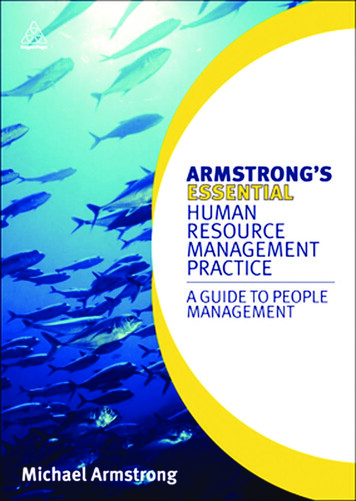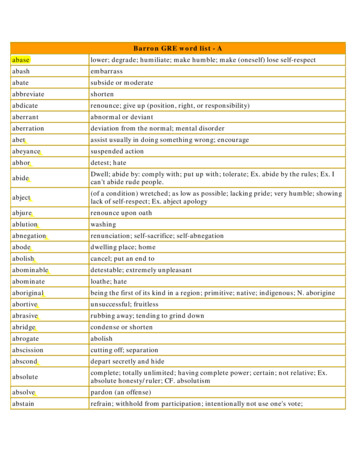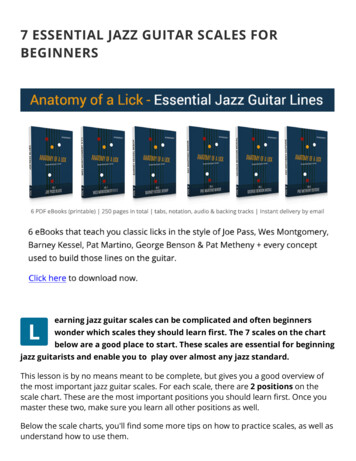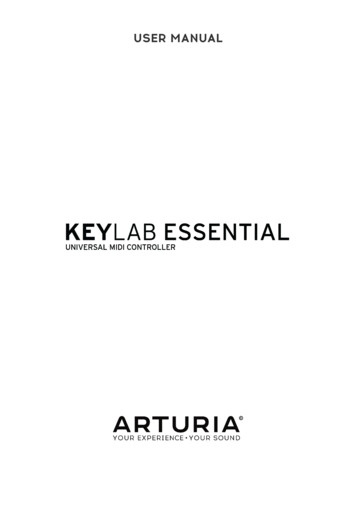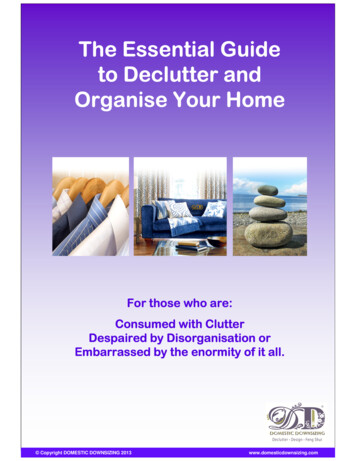
Transcription
The Essential Guideto Declutter andOrganise Your HomeFor those who are:Consumed with ClutterDespaired by Disorganisation orEmbarrassed by the enormity of it all. Copyright DOMESTIC DOWNSIZING 2013www.domesticdownsizing.com
Table of contentsWhy do we need to declutter?.3The roots of clutter .5How did I get here?.8What is your organising style?.10The mechanics of decluttering . . . . 14How to whittle down your wardrobe . . . . .16How to control children’s clutter . 1813 top tips to make the job easier . . . .20What does a Professional Organiser do?.22About the author. . . . 23Like to know more?. . . . 24 Copyright DOMESTIC DOWNSIZING 2013www.domesticdownsizing.com
Why do we need to declutter?Most people know they need to declutter, but many don't realise thebenefits that will result when they finally do. You can do it on your own, oryou can get a helping hand from a professional organiser, but whicheverway you do it everyone in your life will benefit.So in no particular order, here are my top four reasons why declutteringwill improve your life - and the lives of those around you.Improving your emotions and outlook on life: It is a well known fact that a cluttered home is a reflection on how you arefeeling about life – decluttering helps to develop a positive frame of mindthat naturally helps you to organise Decluttering helps to free your mind, to think clearer, to be less stressedand to concentrate on the “now” not the past or future.Improving your finances: How many times have you bought the same thing twice because youcouldn’t find it the first time? How many times have you bought “bargains” only to find you don’t needthem and they then clutter up your house? How many times have you misplaced bills so you had to pay late fees? Orlost Lotto tickets? Or found cheques that had not been deposited and wereout of date?Now, where did I leave the baby? Copyright DOMESTIC DOWNSIZING 2013www.domesticdownsizing.com
Why do we need to declutter?Improving your health: No more articles around the home collecting dust Fresh air can circulate helping you to breath Being organised gives you more time for things you want to do – cooking,exercising, family time, taking a bath – you time.Improving your social life: You can find your kitchen bench tops again so you can cook and entertain Your dining room table is clear so you can sit down to dinner with family You are no longer embarrassed to have visitors around for a BBQ Visitors can stay the night in your new guest room.Eating at the dining room table – just like we used to. Copyright DOMESTIC DOWNSIZING 2013www.domesticdownsizing.com
The roots of clutter:External, behavioral and internal*Before you begin to declutter, ask yourself what is the underlying cause. There areinnumerable reasons people are plagued by clutter. You may see your clutter issuesoriginating from more than one of these three categories — or even from a causethat isn’t external, behavioural, or internal. Clutter is a complex issue, but knowingwhy it is in your life can go a long way to helping you find a solution.1. External: Living with a cluttered person, physical disability, inherited clutter.Clutter rooted in external causes can be more challenging to overcome. Since youcan’t change other people, you may be continually plagued with clutter as long asyou live in the same space as that person. If you’re struggling with inherited clutter,the situation may be stressful as you take the time to sort through emotional issues.Case study: Mismatched couplesJane and Patrick, both in their late 30’s have been married for two years. Jane istidy and organised, Patrick is more casual in his cleanliness habits. Jane alwaysfeels she is nagging Patrick to pick up after himself which causes her stress. Patrickdoesn’t seem to notice and adds to the clutter by bringing home giveaways fromtrade shows and is annoyed if Jane attempts to throw any of his things out. Aftertrying different tactics to get Patrick to help around the home, Jane has resignedherself to do all the decluttering and tidying herself.Not seeing eye-to-eye with your partner?* Adapted from a blog by Unclutterer.com Copyright DOMESTIC DOWNSIZING 2013www.domesticdownsizing.com
The roots of clutter:External, behavioral and internal2. Behavioural: Challenges with decision making, lack of energy,organising skills.Clutter resulting from behavioural causes can be more manageable than theother categories of clutter.You can learn or improve skill, change habits, and find ways to increase energylevels. It can take time and commitment to overcome these behaviours, but itcan be achieved within a reasonable amount of time.Case study: New mothers and working mothersCatherine is in her mid forties and works in the medical records field. She has tobe extremely organised in her role and can find any record within seconds. Backin the home however, it is another story. Before she had children, Catherine wasvery organised and had time under control. But now with the kids in school, sheback at work full time, husband working full time and with all of the extracurricular sports and activities, it barely leaves time for Catherine to get dinneron the table, let alone have friends over for a BBQ or declutter the junk/guestroom for when mother-in-law comes to visit for Christmas.Trying to juggle groceries, children, your life? Copyright DOMESTIC DOWNSIZING 2013www.domesticdownsizing.com
The roots of clutter:External, behavioral and internal3. Internal: Grief, depression, anxiety, distrust, overly sentimentalInternal clutter is similar to external clutter in that its solution varies greatly fromperson to person. Seeking professional assistance from an outside source is a goodidea such as uncluttering assistance from a professional organiser.Case study: Death of a parent and/or partnerJohn Henry, aged in his late 70’s was my father. My mother had died ten yearsearlier and dad had had a hard time coming to terms with the death of his partner ofover 40 years. Although he had done well in clearing out our mother’s things, he hadsoon filled the gap by becoming a regular shopper at thrift shops such as St VincentDe Paul and Life Line. It didn’t take long for the house to start filling up with secondhand odds and ends: paintings, stuffed toys, kitchen items, clothing, tools etc. Abrother who was still living at home had to move out due to the clutter and anotherbrother who tried to help, soon realised Dad was happy to live amongst it all. Afterhe died, it took the family almost 18 months to clear the house out ready for sale.Hoarding is specific type of behaviour characterised by acquiring and failing tothrow out a large number of items that would appear to have little or no value toothers (e.g., newspapers, plastic bags, rubbish) so that the home is no longer able tofunction as a viable living space. There are many different levels and causes of thiscondition and it is always recommended to seek professional helps in these cases.Internal clutter V’s hoarding Copyright DOMESTIC DOWNSIZING 2013www.domesticdownsizing.com
How did I get here?The hard questions you need to ask yourself before you start:Why am I in this situation? (see the roots of clutter on previous pages)What has prompted me to take action now?How do I visualize this space to look and work for me? Copyright DOMESTIC DOWNSIZING 2013www.domesticdownsizing.com
How did I get here?What is working for me in this space (if anything)?What has prevented me from being organised in the past?What sort of organisation style do I have? (see next pages) Copyright DOMESTIC DOWNSIZING 2013www.domesticdownsizing.com
What is your organising style?In sightThe “in sight” organising style is where clients like to visualise what they have,from plates/glassware on shelves in the kitchen rather than behind cupboarddoors and to books on shelves and files displayed on the desk where they cansee them.They tend to panic when things are hidden away. They are afraid that if theycan’t see it, they will forget about it (and if it’s a to-do, forget to take care of itin time).For developing organisational systems for this client I would use open storagetools to make sure that they can view items – clear plastic containers andfolder file boxes instead of drawers and shelves instead of closed cabinets, andtoaster racks on desk tops rather than filing cabinets.Labels should still to be used on files, folders and boxes so they can easily seewhat is what and grouped together in categories. Colour coding is anothergreat tool for this style of organising.For those who love to see their collections Copyright DOMESTIC DOWNSIZING 2013www.domesticdownsizing.com
What is your organising style?Out of sightAlmost opposite to the above style – this client likes things to be hidden awaybehind doors and nothing left on counters or on desks; they like things storedin lidded solid boxes. Their houses may appear to have a very minimalist style.They can’t tolerate anything on display – the desk or countertop must be clearbefore they can concentrate.For this client I would organise storage in opaque and enclosed storagesolutions – like file wallets and pockets. A colour coded folder and colour labelsystem for filing works well for this style also.They should only have the one diary system for all aspects of life so theirappointments don’t get hidden away either as they don’t like to have a calendaron view on the wall.Everything is hidden with the minimalistic style Copyright DOMESTIC DOWNSIZING 2013www.domesticdownsizing.com
What is your organising style?It’s here somewhereThis client likes to collect things and doesn’t like to throw things away. Acommon cry is “I’ll need that one day” or “I am going to read all of thesewhen I get time”.This client needs more assistance to break the emotional bonds of things.They need to recognise they can only keep what space permits now and notto keep things for a rainy day. They shouldn’t bring home things justbecause they were a bargain or were free.Their possessions need to be sorted into storage systems that are easilyaccessible otherwise they won’t use them. Essential older items need to beput into labeled archive files and boxes.Is that my computer amongst all that clutter? Copyright DOMESTIC DOWNSIZING 2013www.domesticdownsizing.com
What is your organising style?Everything in its placeThis is a client who loves a label maker and needs to cut back on being aperfectionist. Everything is “just so” and they get quite annoyed if thingsare moved or not where they should be.The organising solution for these clients is to keep in control and todevelop systems for the people around them to keep in line with their highstandards.e.g. In the office, file cards for people to write their name/date when theyborrow something and name labels in books, on pens, on clothing etc sothey will be returned.They need easy access to everyday supplies so labelled boxes on labelledshelves are great as is a calendar or year planner on the wall with allappointment and return details marked on it.They also love lists so make sure they have a big visual notebook/diary inthe “control room” so they can tick off as they achieve tasks.A place for everything . Copyright DOMESTIC DOWNSIZING 2013www.domesticdownsizing.com
The mechanics of declutteringEnough already.The first step is that you have to want to change – not someone else in yourfamily or friends. If you are happy with the way you are and it is not affectinganyone else so be it. However, if your clutter is causing problems within thefamily or your lifestyle and you want to get rid of it, a decision must be made.Why did it happen?How did you get to point? Was it the death of a family member and youinherited their belongings? Are you time poor and just don’t “get around to it”?Do you not like to throw things away such as children’s artwork or things youthink you may need “one day”? If the situation doesn’t change, no amount ofdecluttering/organising will help.Assess – and make a mess.Sorry to say it, but to declutter you first need to make more clutter. The spaceyou are working on needs to be stripped – everything taken out, then given agood clean before items are put back. So where does it all go? Assign a spot inthe house that you can spread all the items out to be sorted and purged.Sort - putting “like” with “like”When items are removed from the space, make piles. Firstly a keep pile, adonate/sell pile and a garbage pile. Then start putting the same categories ofitems together ie stationery, books, shoes etc. This makes it easier to see howmany of each category you have (and no one needs 3 staplers.)Pass on your unwanted goods to those who will appreciate them Copyright DOMESTIC DOWNSIZING 2013www.domesticdownsizing.com
The mechanics of declutteringPurge.The fun (or not so fun) part. It’s time to let go.Ask yourself 3 questions: Do you love it? Do you need it? Is it useful?If you can’t answer yes to one of these questions out itgoes. Only the “yes” items are returned to the space.Note: This process becomes quite time consumingwhen there is emotional ties to items such aschildren’s clothing, sentimental items, gifts etc.Storage – remember your style?When it comes to organising and storage you musttake into consideration what type of organiser youare. Do you like things “out of sight and out of mind”behind cupboard doors, or do you like to see things inclear plastic boxes and on shelves otherwise youforget about them? This determines what storageitems to buy and how you will design the room.Note: first use containers you may already havearound the house before you spend on more.Maintain - just 5 minutes a dayNow that you have decluttered and organised youmust keep up the good work. Five minutes a day toput things away is all it takes. Make sure all the familypitch in and do their share. Copyright DOMESTIC DOWNSIZING 2013www.domesticdownsizing.com
How to whittle down the wardrobeSpace invadersWe only wear 20% of our wardrobe. Put your favourites aside then sortthrough the remaining 80% into piles: throw, donate, sell, repair/tailor.Size mattersDon’t put yourself through the torture of keeping clothes that you oncefitted into – who wants to be reminded? Enjoy your size now.Oldie but a goodieClassic pieces last for years – as long as it hasn’t dated, is in goodcondition and you still wear it.What’s it made of?For staple pieces in your wardrobe, invest in items made with qualityfabrics – not only do they feel better on, they will last longer as wellMoney mattersWhat is your budget – do you crave variety and follow the currenttrends, or would you rather spend your money on timeless pieces thatwill last for years?It’s easy to get ready when your wardrobe looks like this Copyright DOMESTIC DOWNSIZING 2013www.domesticdownsizing.com
How to whittle down the wardrobeIf the shoe doesn’t fit You don’t want sore aching feet with blisters andbunions so unless they are your favourite Manolosthat you only wear to special occasions sitting down– ditch them.If it’s broken – fix itMend your clothes as soon as they need fixing – popthem in a basket next to the lounge for easy access.Otherwise every time you go to wear them you can’t.For all seasonsPack away your out of season clothes such as bulkyjumpers in summer and bikinis in the winter and dothe change over in spring/autumnPass on the hand-me-downsJust because your sister gave it to you doesn’t meanit’s your style – if you don’t want to offend, accept itthen pass it on or donate it.How do you dress?Work clothes with work clothes, colour with colour,dresses all together – whatever works for you gettingdressed in the morning is how you should organiseyour wardrobe. Copyright DOMESTIC DOWNSIZING 2013www.domesticdownsizing.com
How to control children’s clutterGive everything a homeJust like in the movie Toy Story, kids have vividimaginations so give all their toys a place to go to sleep eachnight. Cars and trucks go into the “garage” cupboard, dollsgo to sleep in their “apartment” boxes etc. Putting awayneedn’t be the end of play.Make storage see-throughIf you can see what it in the box, it is easy to put things away.They are also great for mum to store clothing or toys waitingfor younger children to grow into them. Make it easier stillby labelling the outside and have them all the same size foreasy stacking and storage.Keep it off the floorCreate new storage space by using hooks and hangingstorage such as baskets and bags. Great for stuffed toys, dollsand other lighter items. Also a perfect idea in the garage forkeeping control of all the sports gear (so you don’t trip overthem).Be creative with storageLook around the room – where else do you see space thatcould be utilised for storage? How often does your luggageget used? Use a suitcase to stash your children’s out ofseason clothes and hide under their bed.Rewards & incentivesRewards tend to work better than punishments so offerincentives for picking up after themselves and puttingclothes away (a reward point system chart is a good idea).These good habits will stand them in good stead as they getolder. Copyright DOMESTIC DOWNSIZING 2013www.domesticdownsizing.com
How to control children’s clutterMake organising fun and easy. Put labels on everything or a coloured dot code onitems that are placed in each drawer or storage container. Ifsiblings argue over possessions give his or her own colour. Giveeach child their own coloured laundry basket to look after (right).School schedules & suchFor each child have a different coloured binder with clearpockets, and in each pocket have a topic such as school notes,timetables, sports schedules, doctors appointments etc. Matchthe colour of the binder to coloured dots to use on a large displaycalendar on the wall or fridge for appointments.Never ending artwork.Keep a folder for each child’s artwork as it comes in the door. Atthe start of each school holidays, go through the folders with yourchild and let them choose their favourite two or three to keep.The “keepers” can then go into a yearly envelope and at the endof the year, make them into a scrapbook with other mementos(such as tickets to theme parks etc).Keeping clutter under control (or learn how to shut thedoor).Now that the kids are clutter free and organised, how do you keepit that way? Just like adults, kids have their own organisingstyles. Some will love the colour coding system and puttingthings away, others love the “everything on the floor” system. Theimportant thing here is: don’t stress. It is their own space so aslong as they can find the important items such as their schoolclothes/homework and the clutter doesn’t come out into themain living areas, learn to shut the door (or resign yourself to bepicking up after them until they leave home). Copyright DOMESTIC DOWNSIZING 2013www.domesticdownsizing.com
13 top tips to make the job easier 1.Avoid overwhelm - break the job down intosmaller goals. Remember the saying “How doyou eat an elephant? One bite at a time.”2.Take regular breaks for a cup of tea and quicksit down – but not for too long, keep thatmotivation going3.Ask for an extra pair of hands from family andfriends. Make it a game and get the childreninvolved4.Tell someone what you are doing & have themcall to check on your progress – make yourselfaccountable5.Be clear from the beginning what your goalsare and what you plan to achieve6.Set a time limit each day: 5 mins minimum - 4hours maximum7.Play energetic music and keep hydrated8.List rewards you will have when you completea task (space to cook, a lovely place to read, arug you haven’t seen for a while, the familysitting around the dining table etc) or list thecost or consequences if you don’t (late fees,having take-out again, embarrassment if aneighbour pops in) Copyright DOMESTIC DOWNSIZING 2013www.domesticdownsizing.com
13 top tips to make the job easier 9.Ask yourself: “Where am I organised in thehome?”You may have a great system forkeeping track of kids schedules, storage foryour photos or memorabilia, or the linencupboard may be a work of art. Whatorganising strategies do you use in these areasthat you could apply to other areas of yourhome or life? Can you use this motivation tokeep decluttering/organising the whole home?10. Take a day off – remember Rome wasn’t built ina day and you don’t want to get discouraged11.Make an agreement with yourself to set aday/time when you will start again and put iton your calendar12. Watch an organising show on TV to getinspired or find magazine articles or search theweb for other tips you can use13.Enlist the services of a Professional Organiserto give you a hand and keep you motivated(read more on the following page).Most of all make it fun - and enjoy yournew uncluttered & organised home. Copyright DOMESTIC DOWNSIZING 2013www.domesticdownsizing.com
What does a professional organiser do?ProfessionalOrganisersassisttheirclients on a personal and/or businesslevel to help with clutter, productivity,timemanagementandorganisingspaces and systems. Clutter doesn’thave to be physical — you can have timeclutter or mental clutter or even badprocesses that qualify as clutter.The work can either be conducted as a personal advisory service, hands-on or virtuallyvia the internet, depending on the needs and location of the client.A Professional Organiser can help you declutter and streamline your home and youroffice, design a new filing system, coordinate paperwork management, maximise yourspace with creative storage and archiving solutions, organise time management, coordinate repairs and maintenance and much more.Most importantly, a good professional organiser will develop a personalised system soclients can maintain a clutter free and well organised home or office after the sessionsare completed. Professional Organisers do not tell you what to do; their role is to offerguidance in how to make decisions that are best for you whilst respecting the thingsthat are most important to you.Getting organised is not all about throwing things away - the focus is assisting clientsto organise and manage their possessions and surroundings, not the other way around.A typical session with a professional organiser lasts for four hours and focuses on theareas that the client has the highest priority. After the session, a report is usuallyproduced on how to stay organised, clutter free and utilising space and is followed upwith support calls or emails if preferred.It's a central part of a professional Organiser’s philosophy to ensure they impart theskills, tools and motivation their clients need to maintain their new environment. Copyright DOMESTIC DOWNSIZING 2013www.domesticdownsizing.com
About the author If anyone knows the despair of having too much clutter, it is me.Being one of nine children with a father who was a hoarder, I grew up with muchclutter and as my husband David is in the defence force, we moved 15 times over22 years.After packing, unpacking, purging and organising all our possessions so manytimes, I certainly understand how stressful it can be however this is theimportant part: I have developed many decluttering and organisational strategiesalong the way to make it easier.And this is how Domestic Downsizing - Declutter & Design was born. I have over 22 years experience in decluttering & organising I have a Diploma in Interior Design I have been trained as a professional organiser by Australia's first accreditedExpert Professional Organiser I am a Feng Shui Consultant having trained with Australia's leading Real WorldFeng Shui Practitioner I am a member of both the Australasian Association of Professional Organisersand the National Association of Professional Organisers (USA) I am a member of the Association of Feng Shui Consultants InternationalDomestic Downsizing is here to help. No job is too big or too small.Don't feel overwhelmed any longer – remember each mountain is conqueredstarting with one small step. I look forward to helping you and your family onyour way to domestic bliss. Copyright DOMESTIC DOWNSIZING 2013www.domesticdownsizing.com
Like to know more & keep in touch?Keep up to date with new information on decluttering,organising and having a balanced life:Subscribe to my newsletter: http://tiny.cc/zolsvWebsite: http://www.domesticdownsizing.comBlog: http://www.organizeme.com.auFacebook: http://www.facebook.com/domesticdownsizingTwitter: http://twitter.com/OrganiseMeLinkedIn: http://au.linkedin.com/in/organisemeYouTube: http://www.youtube.com/user/OrganiseMeEmail: kerri@domesticdownsizing.com.auBest of luck in your decluttering& organising endeavours!Kerri RodleyProfessional OrganiserHome stylistFeng Shui Consultant Copyright DOMESTIC DOWNSIZING 2013www.domesticdownsizing.com
Improving your emotions and outlook on life: It is a well known fact that a cluttered home is a reflection on how you are feeling about life –decluttering helps to develop a positive frame of mind t







